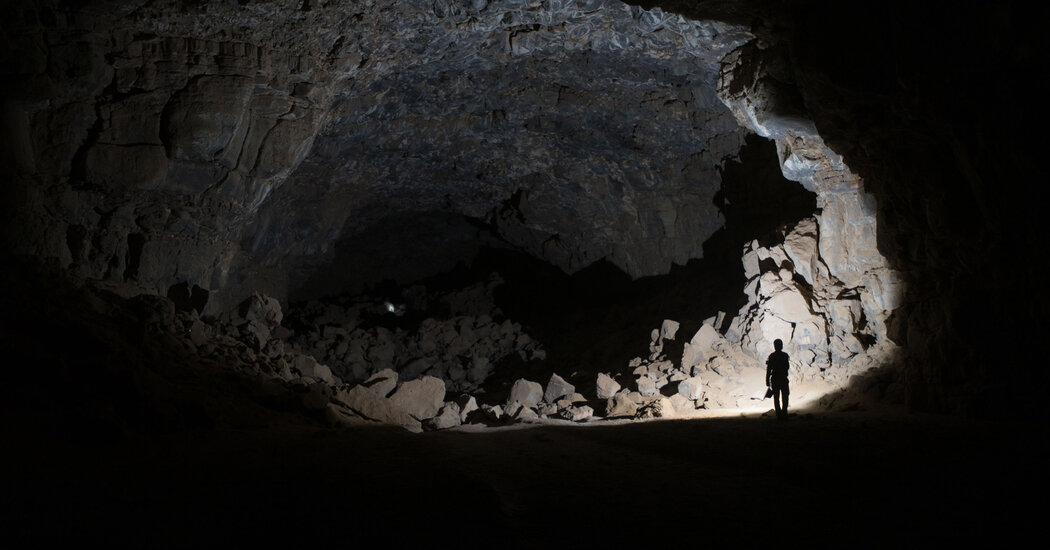

Volcanic eruptions set off a mass extinction 252 million years ago that scientists call “the Great Dying.” The ensuing climate change and acid rain hit life in the oceans hard, with less than 5 percent of marine species making it out alive.
But that event gave strange new life-forms the opportunity to evolve, including a small sea-dwelling reptile that filter-fed much as bowheads and other baleen whales do today. The discovery was reported on Monday in the journal BMC Ecology and Evolution.
The reptile in question, Hupehsuchus nanchangensis, arrived on the scene a few million years after the Great Dying. Unlike the massive sea monsters that eventually evolved, it was about three feet long, including its tail. And unlike many of its relatives, Hupehsuchus had no teeth in its skinny snout.
In the decades since it was first discovered in 1972 in Hubei Province in southern China, scientists have puzzled over how Hupehsuchus might have been able to snag its meals. Cheng Long, a paleontologist at the Wuhan Center, China Geological Survey, has suspected for years that Hupehsuchus might have been a filter feeder, gulping mouthfuls of tiny zooplankton and straining out the seawater. However, soft tissues for filtering meals, comparable to the bristles that make up modern whales’ baleen, have not been found. Additionally, Hupehsuchus fossils tend to be preserved in flattened slabs. The angles and quality of preservation of the specimens’ skulls have made it difficult to identify similarities to the skulls of modern filter-feeding whales.
That changed with the discovery of two new Hupehsuchus specimens, also from Hubei: one complete skeleton, and one of the head, neck and clavicle. Crucially, both fossils give a clear view of the skulls from above.
“When we first saw these specimens, we thought they were very strange,” Dr. Cheng, an author of the new paper, wrote in an email. “We thought that the snout shape of H. nanchangensis was similar to that in modern baleen whales.”
Inspired by the skulls’ similarities, Dr. Cheng and his colleagues compared Hupehsuchus skulls with those of 130 modern aquatic species, including baleen whales, toothed whales, seals, crocodiles, water birds and platypuses. The researchers mapped the skulls and charted ways they aligned with different sizes of prey. Hupehsuchus and its close relatives’ skull proportions overlapped with modern baleen whales’ skulls, indicating that the ancient reptiles were filter feeders, too.
Hupehsuchus’s relatively stiff body meant that it probably skimmed along near the surface with its mouth open, like a bowhead or right whale, rather than diving deep like a humpback. While baleen is a soft tissue and thus is less likely to fossilize, the researchers noted the presence of grooves in the roof of Hupehsuchus’s mouth, which may have anchored baleen-like tissues.
Based on these findings, Hupehsuchus appears to be the earliest known example of a filter-feeding, four-limbed vertebrate. While filter feeding is seen in many modern whales, it was rare in marine reptiles.
Nick Fraser, a paleontologist at National Museums Scotland who was not involved with the study, said that he was persuaded by its conclusions. “I think they’ve got it right, how these animals fed,” Dr. Fraser said. What’s more, he said, Dr. Cheng and his colleagues opened up a bigger question, of how Hupehsuchus evolved its method of feeding comparatively quickly in the wake of the Great Dying.
“The evolution of this type of very, very specialized feeding mechanism took at least 30 million years in whales,” Dr. Fraser said. Reptiles like Hupehsuchus developing filter feeding in just three million years after the Great Dying means that “there was a heck of a lot of evolution going on.”
Dr. Cheng said that the timing of Hupehsuchus’s appearance, right on the heels of the mass extinction and precipitating a takeover of the oceans by reptilian predators in the era of the dinosaurs, made it more than just an evolutionary oddity. “It’s been amazing to discover how fast these large marine reptiles came on the scene and entirely changed marine ecosystems of the time,” he said.
24World Media does not take any responsibility of the information you see on this page. The content this page contains is from independent third-party content provider. If you have any concerns regarding the content, please free to write us here: contact@24worldmedia.com

This Lava Tube in Saudi Arabia Has Been a Human Refuge for 7,000 Years

Four Wild Ways to Save the Koala (That Just Might Work)

National Academy Asks Court to Strip Sackler Name From Endowment

Ways Industrial Copper Helps Energy Production

The Ins and Out of Industrial Conveyor Belts

She Dreams of Pink Planets and Alien Dinosaurs

Why Your Family Should Play With Your Pet Outdoors

Arkansas Braces for Flood of Tourists During Total Solar Eclipse

New England Journal of Medicine Ignored Nazi Atrocities, Historians Find

Judge Orders Timely Housing for Migrant Children Waiting at Border

Community calendar: April 4, 2024

Real Estate Transfers: April 4, 2024